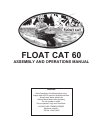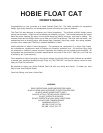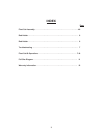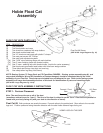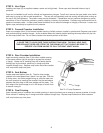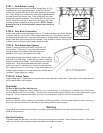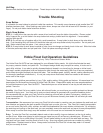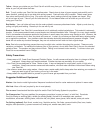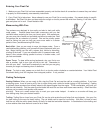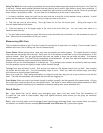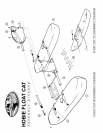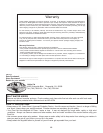
Tether: Always use a tether so your Float Cat will not drift away from you. All it takes is a light breeze. Secure
tether to your calf just below the knee.
Exit: To exit, position your Float Cat into shallow water. Reach down to tops of apron support posts and tilt post in
same direction, pushing ring to one side while pulling upward. Posts will snap off of crossbar. Detach mesh apron
from velcro and bunch to front of ring. Flip apron over your head, making sure hull bag zippers are closed. Ring
will sit on bows of boat. Take off your fins and stand up. Do not detach tether until on shore so you will not risk
losing your Float Cat.
Rod Holder: Your rod holder will snap into the outer molded-in accessory attachment holes. Adjust up and down by
pulling out lightly and twisting. Remove pin for use with fly rod.
Pontoon Material: Your Float Cat is manufactured out of rotationally molded polyethylene. This material is extremely
durable. It is the same material used on most kayaks and industrial sanitation bins. Although it is a very tough material,
if left in hot weather with pressure applied to the pontoon in small areas, the pontoon may develop a dent. However, the
material has a memory and in time, any dents will come out. In short, do not store your boat with heavy objects resting
on or against the pontoons. Your pontoons could also develop dents with temperature and pressure changes. These
dents will not cause any structural damages, they are not unusual and will return to their original shape.
Note: Due to the manufacturing process there may be slight color variation throughout the product. These are color
variations, not defects. To maintain the lustrous color of your pontoon, do not store Float Cats in the sun for extended
periods of time. The pontoon and bag colors will fade. Fading is not covered under warranty. To shine or clean your
Float Cat we recommend Lemon Pledge.
Safety Precautions
• Always wear a US. Coast Guard Approved Flotation Device. As with canoes and kayaks, there is a danger of falling
overboard. Always keep your weight centered. Flotation devices are mandatory for your safety.
• Your Float Cat was designed for Class 1 water or less. It was not designed for rough water, rapids, or high wind
conditions. Always use common sense and take weather, wind and water conditions into account before using
your Float Cat.
• Use common sense when using waders. Always wear a wader safety belt to keep water from entering your waders in
case you need to get off your boat or you end up in the water.
• Always attach the supplied tether to yourself so you will never get separated from your boat.
Suggested Additional Equipment
Waders: Use chest or waist-high waders. Neoprene is safest and best for cooler waters and optional in warm water.
Life Vest: Wear a life vest (required by law in most places).
Fins or oars: Use standard float tube style fins and/or Float Cat Rowing System for propulsion.
For Emergencies: Ping-pong paddles (for emergency propulsion in case you lose 1 or both fins), Parachute
Cord (for towing or securing gear), whistle (for alerting boats), first-aid kit in watertight case, personal
medications, sunscreen, drinking water, wide brim hat, rain jacket, warm gloves, hand warmer, extra pair socks.
For fishing (optional): Rod & reel, marker buoy, float-tube anchor, fish finder, personal tackle (flies, lures, leader,
weights, extra spools etc.), spare or second rod, landing net, needle nose pliers, lunch.
8



